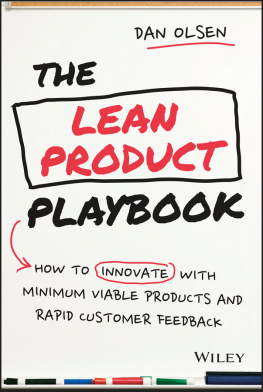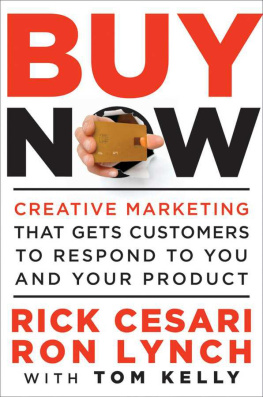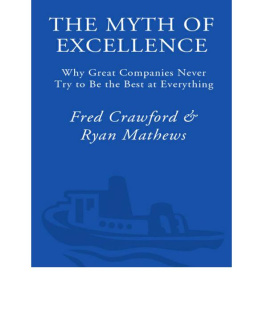PORTFOLIO / PENGUIN
Published by the Penguin Group
Penguin Group (USA) LLC
375 Hudson Street
New York, New York 10014

USA | Canada | UK | Ireland | Australia | New Zealand | India | South Africa | China
penguin.com
A Penguin Random House Company
First published by Portfolio / Penguin, a member of Penguin Group (USA) LLC, 2013
Copyright 2013 by Nicholas Lovell
Penguin supports copyright. Copyright fuels creativity, encourages diverse voices, promotes free speech, and creates a vibrant culture. Thank you for buying an authorized edition of this book and for complying with copyright laws by not reproducing, scanning, or distributing any part of it in any form without permission. You are supporting writers and allowing Penguin to continue to publish books for every reader.
ISBN: 978-1-101-63144-7
To Catherine, Alasdair and Lucy
Preface
Steal it. Steal away. Steal, steal and steal some more and give it to all your friends and keep on stealing, because one way or another these mother fuckers will get it through their head that theyre ripping people off and thats not right.
The words of an anarchist? A member of the Pirate Party? No, those are the words of Trent Reznor, the front man of Nine Inch Nails, an industrial rock band that released its first album, Pretty Hate Machine, in 1989. By 2007, at a gig in Sydney, here was Reznor exhorting his fans to steal his music and calling his record label greedy fucking assholes.
How did it come to this, and how did Reznor expect to make money if his fans were all downloading his music for free?
Reznor grew up in rural Pennsylvania, a place where there was nothing going on but the cornfields.
Despite his musical abilities, Reznor chose to study computer engineering at Allegheny College, but dropped out after a year to move to Cleveland with the intention of becoming a full-time musician. Reznor asked if he could use the studio to record demo tracks himself. How could I possibly stand in this guys way? said Koster, interviewed in 1995. It wasnt costing me anything, just a little wear on my tape heads.
Reznor had found a recording studio. The trouble was that he couldnt find musicians willing to work between 3 a.m. and 8 a.m., without pay. So he did what any self-respecting, driven perfectionist would do. He decided to play all of the instruments himself. After all, he reasoned, it had worked for Prince.
It worked for Reznor, too. He soon signed with TVT Records and released the Nine Inch Nails debut album, Pretty Hate Machine. It sold a million copies, and TVT put pressure on Reznor to create another commercial success. In a pattern that was to be repeated throughout Reznors career, and would ultimately lead to his split from the traditional record-label system, Reznor resisted this interference in the creative direction of Nine Inch Nails, leading to a vicious court battle.
Eventually, Reznor broke with TVT and signed to the Interscope label, releasing the EP Broken in 1992. Over the next decade, Reznors music career followed an almost clichd path: huge success with The Downward Spiral, a long period of drug-fuelled writers block and successful collaborations with, amongst others, singer Marilyn Manson, film director Oliver Stone on Natural Born Killers and game developer id Software on Quake.
Reznors relationships with record labels had been fractious in his early days, and they came to a head over the prices that Interscopes parent company, Universal Music, charged for his albums in Australia. In an interview with Music 2.0, Reznor said:
Year Zero is selling for $34.99 Australian dollars ($29.10 US). No wonder people steal music. Avril Lavignes record in the same store was $21.99 ($18.21 US). By the way, when I asked a label rep about this, his response was: Its because we know you have a real core audience that will pay whatever it costs when you put something out you know, true fans. Its the pop stuff we have to discount to get people to buy. So, I guess as a reward for being a true fan you get ripped off.
Thats when Reznor exhorted his astonished fans to steal his music. It was also when he started to look for an alternative way to make money from recorded music.
The phone numbers led to answering machines offering conspiracy theories. Fans found other fake websites strewn across the internet. Before long, internet forums and wikis emerged to debate the messages and theories, culminating in the release of Year Zero in April.
Reznors technology know-how, his dislike of the label system and the emergence of the internet as a viable distribution channel all culminated, in 2008, in a perhaps inevitable outcome. Reznor split with Interscope Records and formed his own label. His next musical release was a perfect example of how an artist could harness the power of the internet to make a financial success of an album that he gave away for free.
Ghosts IIV is a thirty-six-track instrumental industrial rock album. In fact, its more like four nine-track albums released as one. Reznor decided from the beginning to offer his album at a variety of price points.
Ghosts I he released for free as a digital download. Anyone could download it from his website in return for an email address. Reznor went one step further. He wanted to maximize his potential audience and to do so, he chose to upload Ghosts I to filesharing sites such as BitTorrent and The Pirate Bay.
The full version, Ghosts IIV, was released as a digital album for $5. Of course, many fans already knew how to get this for free from filesharing sites, where the content would appear as soon as the album was released, but Reznor offered his fans an honesty box where they could give him money if they wanted to. There was also a traditional physical CD for $10 and a Deluxe Edition for $75, but Reznors brilliance lay in his $300 Ultra-Deluxe edition.
The Ultra-Deluxe Edition contained a four-LP set of Ghosts IIV on 180-gram vinyl and three embossed, fabric-bound hardcover books in a large fabric slipcase. Each Ultra-Deluxe Edition was numbered and signed by Trent personally. Only 2,500 were produced. They were limited to one per customer.
Reznor sold every single Ultra-Deluxe Edition in less than thirty hours, grossing $750,000. In the first week, his record sales were worth $1.6 million. Yet he gave his content away for free and showed his fans how to find it on filesharing networks that would inevitably carry his entire album within hours of it being released.
Reznor is a trailblazer who has shown us how the transition from analogue to digital has destroyed our preconceptions about the mass market, pricing and the dangers of free.
Businesses of all kinds are under threat from digital and the trend towards a price of zero. The real threat is not piracy; it is competition. When people like Reznor figure out how to give their product or creation away for free and still make more than enough money to keep them in business, it becomes much harder to keep existing price points and ways of trading.
The challenge of the twenty-first century is this: sharing is easy but finding an audience is hard. Consumers expect more and more for free, yet the creation of the products they want is expensive. How can we afford to make the stuff that our audience and customers crave?













